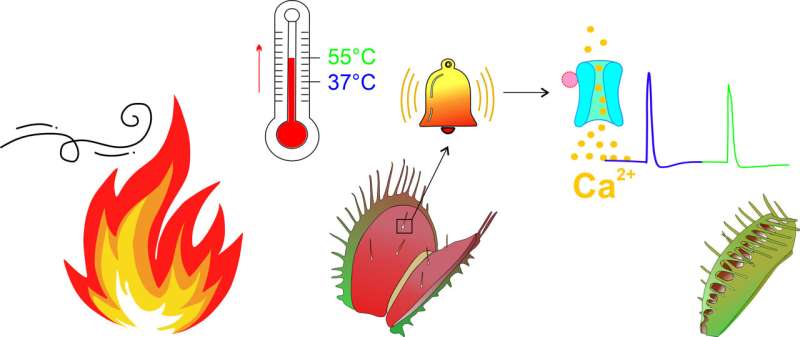This article has been reviewed according to Science X's editorial process and policies. Editors have highlighted the following attributes while ensuring the content's credibility:
fact-checked
peer-reviewed publication
trusted source
proofread
Heat sensor protects the Venus flytrap from fire

The Venus flytrap can survive in the nutrient-poor swamps of North and South Carolina because it compensates for the lack of nitrogen, phosphate and minerals by catching and eating insects. It hunts with snap traps that have sensory hairs on them. If an insect touches these hairs two times, the traps shut and digests the prey.
In its location in the swamp, the carnivorous plant is often not visible because it is overgrown by grass. In summer, the grass dries up. Then it can catch fire from the frequent lightning storms typical of North Carolina—a dangerous situation for the Venus flytrap.
How does the plant protect its vital snap traps and sensory hairs from fire? Biophysicists Professor Rainer Hedrich and Dr. Shouguang Huang from Julius-Maximilians-University (JMU) Würzburg in Bavaria, Germany, have found out: The Venus flytrap uses special heat receptors in the sensory hairs for this purpose, as the researchers report in the journal Current Biology.
Carolina bushfire imitated in Würzburg
"To find out how the flytrap behaves when burning a covering of dry grass, we transplanted plants with open snap traps from the greenhouse to the open field in the JMU Botanical Garden and covered them with hay," says Rainer Hedrich. "Then we set fire to the hay at one end and forced it to spread to the other end with a fan".
After the fire, the plants had closed all the traps. Some traps showed no damage, others appeared to be burnt. After a few days, all undamaged traps were open again and working—they snapped after touching their sensory hairs.
"We had only recently elucidated the stimulus-response chain during trap closure after wounding. Now the question arose whether the traps might already react to the heat wave in the run-up to a fire," says Hedrich.
The JMU researchers were correct in their assumption: a hot air blower directed at the trap was sufficient to cause the trap to close. Next, the scientists conducted heat experiments under controlled laboratory conditions.
The catching organ of the Venus flytrap consists of two leaf halves. Dr. Shouguang Huang brought the outside of one half of the trap into contact with a Peltier element—with this electrothermal transducer, he was able to selectively set different temperatures on the trap through controlled current supply.
He found that when a local leaf temperature of 37°C was exceeded, the heated area of the trap produced an electrical impulse, an action potential that spread across both halves of the trap. "When the temperature increased further to 55°C, a second action potential was triggered and the trap snapped shut," Shouguang said.
But the trap's reaction at 37°C and 55°C only kicked in when temperatures increased abruptly, as in a rapid heat wave. If the temperature rose only slowly, as on hot summer days, the traps did not react.
"In contrast to humans, the heat sensor of the carnivorous plant does not jump when the body temperature is exceeded, but it reacts to the speed of the temperature change," says Hedrich.
By measuring the temperature rise on its surface and closing its traps in a fraction of a second, the flytrap's sensory hairs remain protected from burns. The damp marshy ground further protects them from excessive heat and burns. This allows it to continue hunting for animal food after a fire.
The heat sensor is located in the sensory hairs
Each half of the trap has three sensory hairs that are highly sensitive to touch and generate action potentials. The action potentials are generated at the base of the hairs. There, ion channels that get activated by touch allow calcium to flow into the cells. This calcium signal is the trigger and at the same time an integral part of an action potential. Heat jumps cause the same calcium-dependent electrical events in the sensory hairs as touch.
"To track the calcium signal, we used flytraps that carry a genetically encoded calcium sensor inside them," Hedrich says. When the cellular calcium levels increase, this sensor begins to fluoresce. "We were quite amazed that when the heat was applied, a sensory hair glowed first," he said. "This shows that the hairs operate as touch and heat sensors at the same time," Hedrich concludes.
"Currently, we are pursuing the hypothesis that a calcium channel is an integral part of the heat sensor, or even the sensor itself," the researchers said. If this is true, a type of membrane-bound temperature sensor would have been discovered that is still completely unknown in plants.
So far, research knows calcium channels from the so-called OSCA family, which can be activated mechanically and osmotically. "In the future, we want to test whether there are also OSCAs in the sensory hairs of the Venus flytrap that are switched on by the supply of thermal energy, and which of their protein areas respond to mechanics and which to heat."
More information: Shouguang Huang, Trigger hair thermoreceptors provide for heat-induced calcium-electrical excitability in Venus flytrap, Current Biology (2023). DOI: 10.1016/j.cub.2023.07.069. www.cell.com/current-biology/f … 0960-9822(23)01041-2
Journal information: Current Biology
Provided by University of Würzburg


















